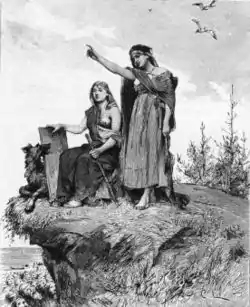Galdr
Galdr (plural galdrar) is one Old Norse word for "spell, incantation"; these were usually performed in combination with certain rites.[1] It was mastered by both women and men.[2] Some scholars have assumed they chanted it in falsetto (gala).[2][3]

Etymology
The Old Norse word galdr is derived from a word for singing incantations, gala (Old High German and Old English: galan) with an Indo-European -tro suffix. In Old High German the -stro suffix produced galster instead.[4]
The Old English forms were gealdor, galdor, ȝaldre "spell, enchantment, witchcraft", and the verb galan meant "sing, chant". It is contained in nightingale (from næcti-galæ), related to giellan, the verb ancestral to Modern English yell; compare also the Icelandic verb að gala "to sing, call out, yell" and Dutch gillen "to yell, scream".
The German forms were Old High German galstar and MHG galster "song, enchantment" (Konrad von Ammenhausen Schachzabelbuch 167b), surviving in (obsolete or dialectal) Modern German Galsterei (witchcraft) and Galsterweib (witch).
Practice
Some incantations were composed in a special meter named galdralag.[2] This meter was similar to the six-lined ljóðaháttr, also used for ritual, but adds a seventh line.[5] Diverse runic inscriptions suggest informal impromptu methods. Another characteristic is a performed parallelism,[5] see the stanza from Skirnismál, below.
A practical galdr for women was one that made childbirth easier,[2] but they were also notably used for bringing madness onto another person, whence modern Swedish galen meaning "mad",[3] derived from the verb gala ('to sing, perform galdr').[6] Moreover, a master of the craft was also said to be able to raise storms, make distant ships sink, make swords blunt, make armour soft and decide victory or defeat in battles.[3] Examples of this can be found in Grógaldr and in Frithiof's Saga.[3] In Grógaldr, Gróa chants nine (a significant number in Norse mythology) galdrar to aid her son, and in Buslubœn, the schemes of king Ring of Östergötland are averted.[7]
It is also mentioned in several of the poems in the Poetic Edda, and for instance in Hávamál, where Odin claims to know 18 galdrar.[1] For instance, Odin mastered galdrar against fire, sword edges, arrows, fetters and storms, and he could conjure up the dead and speak to them.[8][9] There are other references in Skírnismál,[1] where Skirnir uses galdrar to force Gerðr to marry Freyr[7] as exemplified by the following stanza:
34. Heyri jötnar, |
A notable reference to the use of galdrar is the eddic poem Oddrúnargrátr, where Borgny could not give birth before Oddrún had chanted "biting galdrar"[2] (but they are translated as potent charms, by Henry Adams Bellows below):
7. Þær hykk mæltu |
6. Then no more |
See also
Notes
- The article Galder in Nationalencyklopedin (1992)
- Steinsland, G. & Meulengracht Sørensen 1998:72
- The article galder in Henrikson A., Törngren D. and Hansson L. (1998). Stora mythologiska uppslagsboken. ISBN 91-37-11346-1
- Hellquist, E. (1922). Svensk etymologisk ordbok. C. W. K. Gleerups förlag, Lund. p. 177
- The article Galdralag in Nationalencyklopedin (1992)
- Svenska Akademiens Ordbok: galen
- The article galder in Nordisk familjebok (1908).
- Turville-Petre, E.O.G (1964). Myth and religion of the North: the religion of ancient Scandinavia. Holt, Rinehart and Wilson. ISBN 0-837174201.
- Schön 2004:86
- Skírnismál Archived 2007-09-10 at the National and University Library of Iceland at «Norrøne Tekster og Kvad», Norway.
- Skirnismol in translation by Henry Adams Bellows.
- Oddrúnarkviða at «Norrøne Tekster og Kvad», Norway.
- The Lament of Oddrun in Henry Adams Bellows' translation.
Bibliography
- Schön, Ebbe. (2004). Asa-Tors hammare, Gudar och jättar i tro och tradition. Fält & Hässler, Värnamo.
- Steinsland, G. & Meulengracht Sørensen, P. (1998): Människor och makter i vikingarnas värld. ISBN 91-7324-591-7
